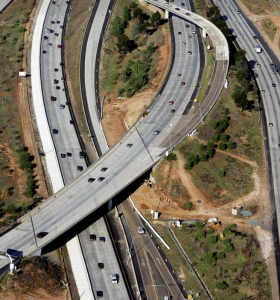Project News
Interstate 15 Provides the Public With a Choice

On a warm January morning under partly cloudy skies, transportation officials stood on an Interstate 15 access ramp high above the free flowing traffic to celebrate the opening of the final segment of new express lanes. The project opened one year early, according to Caltrans District 11 director Laurie Berman, and cost more than $1 billion—a cost well worth the traffic relief and reduced environmental impact.
Caltrans acting director Malcolm Dougherty said, “It’s not every day that we have the opportunity to celebrate the completion of a vital California transportation improvement of the scale and significance of the Interstate 15 Express Lanes project, and to celebrate its completion one year early. The multilateral benefit [this project] provides for the region today and into the future is well worth the tremendous effort that was put into planning, public input, design and construction.”
The new 20-mile stretch of I-15 Express Lanes are what officials call a “smart” transportation solution, with managed lanes that can be reconfigured depending on the traffic flow in each direction. When everyone is headed south into downtown, the middle lanes can be opened to that southbound traffic, easing congestion.
More importantly, the highway is multi-modal, meaning it provides viable transportation options for motorists. There was no previous incentive to take a bus because it was much slower than driving. I-15 now has direct access ramps for busses that take them straight into the less-congested HOV lanes, providing a good alternative to driving.
“We see this project as a national model of how to integrate corridors, and implement effective multi-modalism: by adding highway capacity as well as giving [the public] the choice to drive or use public transit,” said Rick Backlund, associate division administrator for the Federal Highway Administration in Southern California.
Flatiron constructed seven of the 10 managed lanes projects between 2004 and 2012. These projects essentially created a freeway within a freeway by widening the interstate and adding new express lanes down the middle, easing traffic congestion for commuters and residents. Caltrans accelerated the projects by using a contracting method called design-sequencing, under which parts of the design are released sequentially during construction, allowing construction to progress at different areas before the final design is complete.
